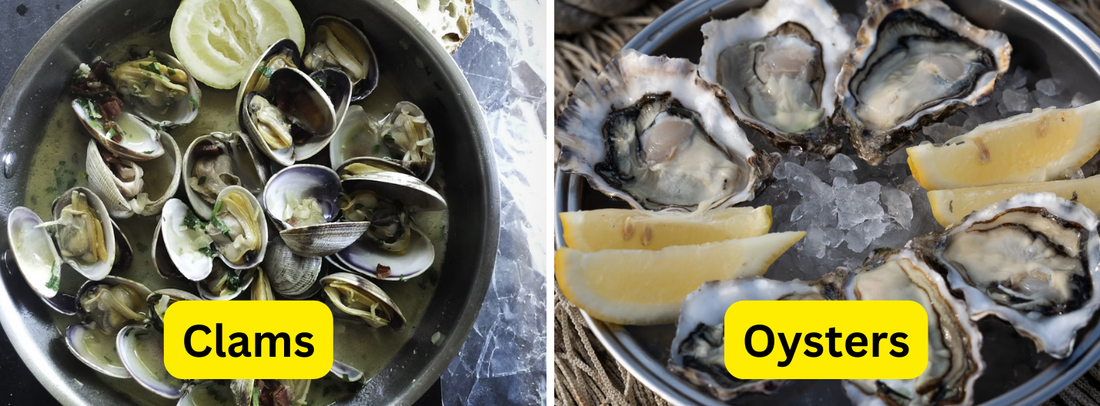Clams vs oysters, two popular seafood dishes, have different features. Today’s article, we will delve into the differences in their appearance, flavor, and culinary uses. By understanding their differences, you can appreciate the nuances of these marine treasures.
- 10 Most Common Types Asian Sauces
- Guide to Classifications and Popular Types of Wine
- What Are Well Drinks? Why Well Drinks Perfect For Happy Hour Menu?
What Are Clams and Oysters?

Clams and oysters are both fascinating members of the bivalve mollusk family, recognizable by their dual shells. These bivalve shellfish can inhabit a variety of environments, living in both saltwater and freshwater ecologies. They are celebrated in global cuisine, each featuring unique culinary applications that cater to different palates and occasions. Understanding the core characteristics of clams and oysters sets the stage for exploring their differences and uses.
Main Differences Between Clams and Oysters
|
Feature |
Clams |
Oysters |
|
Shell Shape |
Smooth, oval, symmetrical |
Rough, irregular, jagged |
|
Habitat |
Buried in sand or mud (coastal waters) |
Attached to rocks or other oysters |
|
Taste |
Mild, sweet, chewy |
Briny, creamy, oceanic |
|
Texture |
Firmer |
Softer, silkier |
|
Eating Style |
Often cooked (steamed, fried) |
Often eaten raw (on the half shell) |
|
Pearls? |
Rare in edible clams |
Can produce pearls (some species) |
Clams are often characterized by their smooth, oval shells and are typically found buried in sand or mud along coastal waters. In contrast, oysters are identified by their rough, jagged shells and are primarily found attached to rocks or even to other oysters in their natural habitats.
Taste & Culinary Uses

How Clams Are Used in Cooking
Clams are versatile and can be prepared in several ways, showcasing their delightful flavor:
- Steamed clams with garlic and herbs: A simple yet flavorful dish that highlights their natural sweetness.
- Clam chowder: A creamy soup that warms the soul, perfect for chilly days.
- Fried clam strips: A popular dish in many seafood shacks, these crispy treats make for an excellent appetizer.
- Pasta with clam sauce (linguine alle vongole): A classic Italian dish that pairs well with white wine, elevating any dining experience.
How Oysters Are Typically Served
Oysters offer a different culinary experience, often celebrated for their distinct taste when consumed raw:
- Raw oysters on the half shell: A delicacy that many enjoy paired with lemon, mignonette, or hot sauce.
- Grilled or baked options (like Oysters Rockefeller): These preparations can offer a richer flavor, complemented by various toppings.
- Oyster stew or seafood platters: Perfect for gatherings, these dishes highlight the versatility of oysters in a more cooked format.
Are Clams and Oysters Healthy?
|
Nutrient |
Clams (100g) |
Oysters (100g) |
|
Protein |
High (~12g) |
High (~9g) |
|
Zinc |
Moderate |
Very high |
|
Vitamin B12 |
Excellent |
Excellent |
|
Omega-3 |
Good |
Good |
|
Calories |
~70 kcal |
~68 kcal |
Both clams and oysters stand out as low-fat, high-protein seafood options, making them great additions to a healthy diet. Oysters are particularly noted for their high zinc content, while clams excel in providing iron and Vitamin B12, both essential for various bodily functions.
Sustainability – Which Is Better for the Planet?
Eco-Impact of Clam Farming
Farming clams brings several environmental benefits:
- Natural filtration: Farmed clams help filter and clean coastal waters, contributing positively to marine ecosystems.
- Resource efficiency: They require no feed, antibiotics, or fertilizers, leading to a lower ecological footprint.
- Low disruption: Often grown in intertidal zones, clam farming can be conducted with minimal environmental disturbance.
Eco-Impact of Oyster Farming
Oyster farming also provides significant ecological advantages:
- Natural water purifiers: Oysters can filter up to 50 gallons of water each day, promoting healthier aquatic environments.
- Ecosystem restoration: They help restore coastal ecosystems, enhancing biodiversity and overall marine health.
- Responsibility in farming: When farmed sustainably, oysters present a minimal environmental impact compared to traditional fishing methods.
Which Should You Choose?

Choose Clams If You Prefer…
- A mild, sweet flavor
- A firmer texture
- Cooked seafood dishes
Choose Oysters If You Prefer…
- A raw, briny, sea-salt flavor
- A silky texture
- A gourmet or fine-dining experience
Conclusion
Both clams and oysters offer a nutritious and eco-friendly seafood option, each with distinct tastes and culinary applications. Your choice ultimately depends on your personal taste preferences, texture sensibilities, and the intended dining style.







